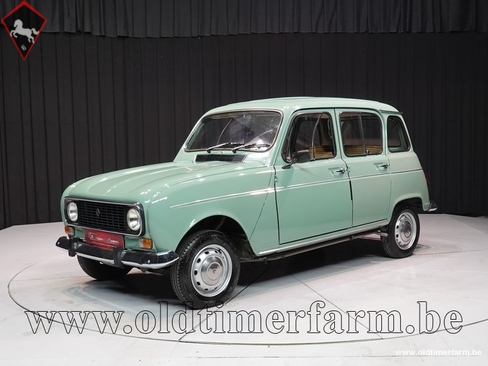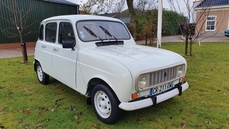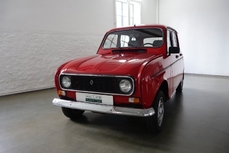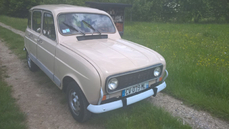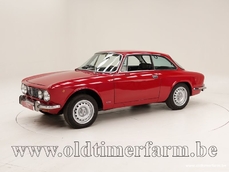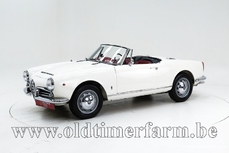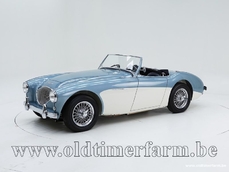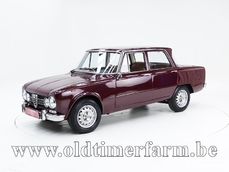Renault 4 '79 1979
Allmän beskrivning :
The Renault 4 or R4 was produced between 1961 and 1994. It is renault's first front-wheel drive passenger car. In France one speaks of the 4L (pronounced "Quatrelle" or "Quatre ailes", which means "four wings"). In 1948 Renault's big competitor Citroën came on the market with the 2 CV. Renault had to respond to this, but in the meantime could also study the strengths and weaknesses of the 2CV. In the spring of 1956, Renault managing director Pierre Dreyfus started a project for a car that would be larger than the 2CV and that would also be more suitable for use in the city. The new car had to succeed the rear-wheel-damaged Renault 4 CV. It had to be suitable for everyone: a family car, a car for women, for farmers, for the city. Only in 1961 the Renault 4 was presented at the Salon de l'Automobile in Paris, in the Luxe (L) version, hence the name 4L, which is common in France. The first versions featured the 750cc engine of the Renault 4CV and a newly developed three-speed gearbox, the first gear of which was not synchronized. With this gearbox, the Renault 4 was behind the now thirteen-year-old Citroën 2CV, which had four instead of three gears. The body was screwed onto a chassis, while its predecessor, the 4CV, already had a self-supporting body. The chassis ran the risk of bending if the (firmness-giving) bodywork was removed; nevertheless, this construction gave Renault an advantage. On the same R4 chassis, Renault was later able to assemble the Renault 6. The R4 had independent suspension on all four wheels, all equipped with suspension by means of torsion bars. The wheelbase is 4 cm shorter on the left than on the right, making it very easy to perform the rear torsion suspension, without affecting the steering of the car. The handling of a Renault 4 is experienced as very comfortable, more comfortable than some modern cars. This is partly due to the smooth torsion bar suspension. During the production of the R4, the model was considered by many to be a station wagon, but in retrospect it might be better to call it one of the first hatchbacks. To date, the R4 did not get the cult status that the Citroën 2CV does, probably because it was the most successful French car of all time. The car was so common that preserving or cultivating the car simply wasn't done. Only in recent years has the cult status of the R4 increased. In the Netherlands, the R4 was for sale until 1986, but production continued in Slovenia, among others, at Revoz until 1993. A total of more than eight million Renaults 4 were produced. Despite its long production time, little was changed in the appearance of the Renault 4. In 1967, the chrome-plated "harp" grille was replaced by an aluminium grille with a Renault logo placed off-centre. There were hardly any changes in the sheet metal: the hood was slightly modified on versions with the 1108 cc engine, and the upper hinges of the door were moved from the outside to the inside in 1982, while the hinges of the tailgate were also reduced. The initially somewhat sm. all bumpers had their final shape from 1967. The interior was nice with comfortable seating, powerful heating and efficient ventilation. The sliding windows gave the R4 an extra character for some drivers, for others it was a sign of an outdated design. The gear lever distinguishes the Renault 4 from other cars, because it is not on the ground, but in the dashboard. The design was copied from the Citroën 2CV, and the result was a flat floor, with more space. The gear lever passed through the dashboard, on the engine and radiator to the gearbox, in front of the engine compartment. As is often the case with a different design, the gear lever was also criticized by journalists, although it was easy to handle. Despite the great success of the Renault 4 (or perhaps as a result of that), Renault has invested heavily in the development of small cars. The Renault 6 and Renault 5 were designed while the Renault 4 was still selling very well, and the R5 was a completely different type of car. This made the Renault 4 a bridge between small cars (2CV, Mini) and the three-door sports car (said Renault 5 and later also the Peugeot 205).
http://www.oldtimerfarm.be/en/collection-cars-for-sale/6657/renault-r4tl-79.php
1979 Renault 4 '79 is listed såld on ClassicDigest in Aalter by Oldtimerfarm Dealer for €10950.
Fakta i bilen
Karosstyp : Personbil Märke : Renault Modell : 4 Modellversion : '79 Motorvolym : 0.0 Årsmodell : 1979 Läge : Aalter
Såld
Information om säljaren
Såld
People who viewed this Renault 4 also viewed similar Renault listed at ClassicDigest
Other cars listed for sale by this dealer
om Renault
Renault, ett namn som är så franskt som en croissant och så djupt rotat i bilhistorien som en baguette på ett parisiskt café. Låt oss göra en avslappnad resa genom historien för denna anrika tillverkare, ska vi?Vår historia börjar i slutet av 1800-talet när bröderna Renault, Louis, Marcel och Fernand, beslutade att använda sina uppfinningsrika sinnen. År 1898 introducerade de sin allra första bil, Renault Voiturette. Det var en liten, bakmotoriserad apparat som såg ut som något Jules Verne skulle ha designat. Denna knappt stora pionjär lade grunden för Renaults bilarv.
Nu, om vi pratar om inflytelserika Renault-modeller får vi inte glömma Renault 4. Lanserad 1961 var den franska svaret på Volkswagen Beetle. Renault 4 var praktisk, mångsidig och utformad för att hantera det tuffa landsbygdslivet i Frankrike. Den trivdes lika bra i staden som på en bondgård, en sann inkarnation av fransk pragmatism.
Men låt oss inte glömma Renault 5, eller "Le Supercinq" som den kallades i Frankrike. Lanserad i mitten av 70-talet var denna lilla halvkombi en design sensation. Dess egenartade, vinkliga linjer och fräcka personlighet gjorde den omedelbart populär. Den var ekonomisk, rolig att köra och blev en ikon för det franska stadslivet.
Sedan kom Renault Espace 1984. Den var en av pionjärerna inom MPV (multi-purpose vehicle)-segmentet. Espace var utformad för familjer som ville ha praktiken hos en van utan att offra komforten hos en bil. Det markerade början på en ny era inom familjebilstransport.
Och låt oss inte glömma Renault Twingo, introducerad 1992. Det var en liten stadsvagn som bröt mönstret med sin innovativa design och bakmonterad motor. Twingo var beviset på att små bilar kunde vara snygga och praktiska, och den blev en hit bland stadsmänniskor i hela Europa.
Nu, om vi vill prata om en verklig spelväxlare är det Renault Clio. Först introducerad 1990 blev Clio en europeisk favorit. Den kombinerade stil, prestanda och överkomlighet på ett sätt som få bilar kunde matcha. Det är den typen av bil som trivs lika bra på Champs-Élysées som den gör när den navigerar genom de trånga gränderna i en fransk by.
Men självklart kan vi inte glömma Renault Megane. Den har varit en stark konkurrent inom kompaktklasssegmentet sedan den debuterade 1995. Med sin distinkta bakdel och ett utbud av motorer för alla smaker har Megane fortsatt att vara en stark konkurrent på en konkurrensutsatt marknad.
Så där har du det, en avslappnad tur genom Renaults historia, ett företag som alltid har lyckats injicera en touch av fransk elegans i bilvärlden. Renault har gett oss bilar som är lika mångsidiga som den franska landsbygden själv, från praktiska arbetsfordon till snygga stadsslickare. Det är ett varumärke som är lika mycket en del av Frankrikes kulturella arv som en flaska Bordeaux eller en omgång Boule. Vive la Renault
